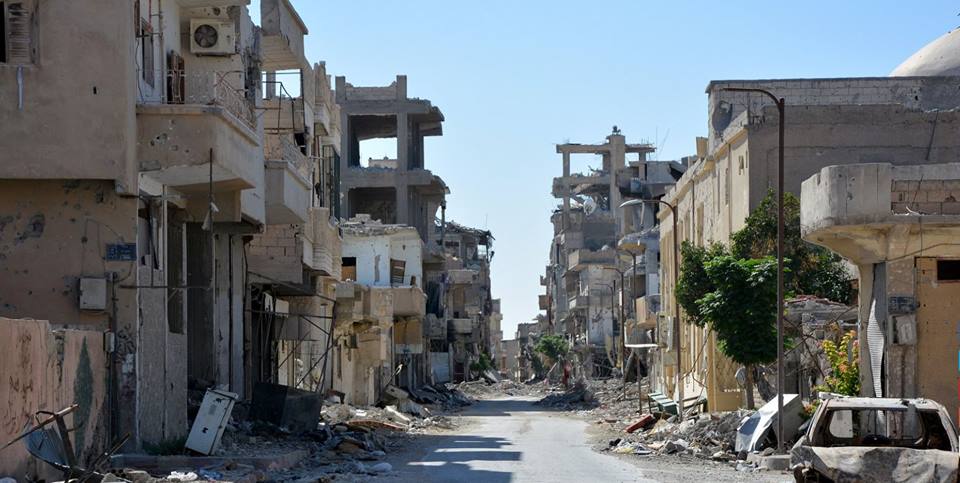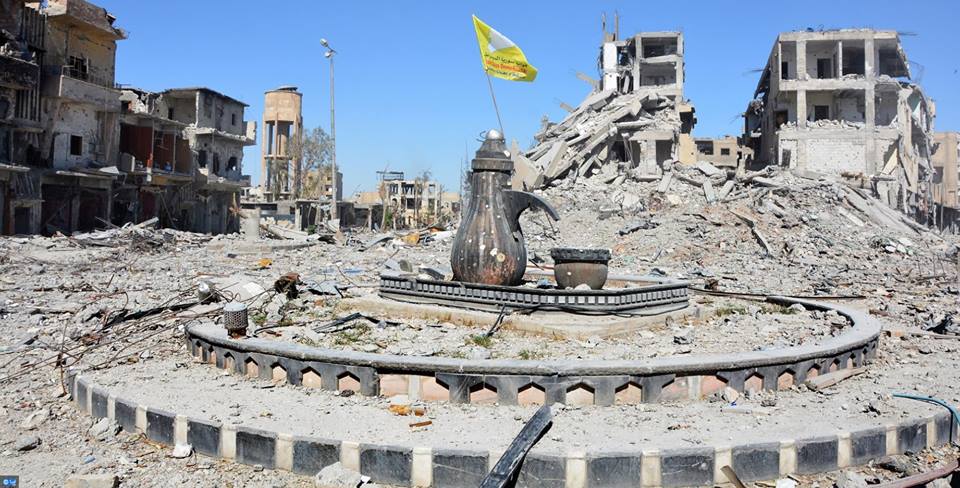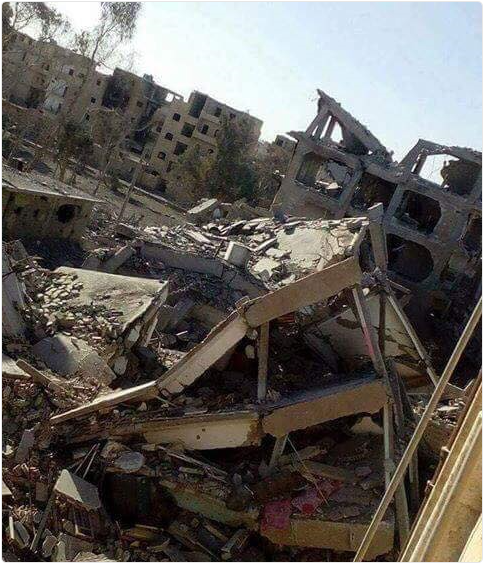Civilians paid a heavy price in the final days of battle for Raqqa – with thousands of Coalition munitions raining down on the city.

During October — the 39th month of the US-led war against so-called Islamic State (ISIS) – the extremist group was confined to ever shrinking territory in Iraq and Syria. Total Coalition strikes fell by 55% from September, and munitions released from the air dropped by 54% to the lowest reported number in any one month since November 2014.
This dramatic fall in activity was not however mirrored in monitored civilian casualties. While Airwars did track a 12% decrease in alleged deaths likely caused by the Coalition in Iraq and Syria, they remained near historic highs – primarily linked to the intense final fight for Raqqa. During October, Airwars estimates that at least 301 non-combatants were killed by Coalition strikes – a figure still higher than at any point prior to March 2017. All but one of the 39 casualty events assessed as likely carried out by the Coalition tracked in October took place in Syria.
The capture of Raqqa, formally announced on October 20th, brought to a close one of the most brutal phases of the anti-ISIS campaign. According to the UN, the five month operation left 80% of the city uninhabitable. Despite a halving of munition use during the abridged period of fighting in October (the last publicly reported airstrike in Raqqa was on October 17th), Airwars monitored at least 266 deaths in Raqqa during the month that were likely due to Coalition strikes — a 9% rise from September.
In total, Airwars now estimates that more than 1,450 civilians were likely killed by Coalition strikes since Syrian Democratic Forces (SDF) pushed into the city at the start of June. Go back to March, when the SDF began encircling Raqqa while backed by Coalition airpower, and that number rises above 2,100 — or more than a quarter of all likely civilian deaths monitored by Airwars during the entire Coalition war.
From June 1st to October 31st, the Coalition reported the use of 20,141* munitions on Raqqa — about 133 every day, or one every eleven minutes or so. This rate was even higher than that recorded in Mosul — the largest city ever controlled by ISIS — during the nine month operation to capture it. More than 29,000 munitions were used in Mosul between October 17th, 2016 and June 29th, 2017. Thousands of civilians were killed in both cities. But in Raqqa their deaths have not received matching press coverage — partly a problem stemming from access limitations imposed by the Coalition’s Kurdish allies on the ground, journalists have told Airwars.
Alleged civilian deaths due to Russian strikes in Syria, meanwhile, fell by a considerable 42% after spiking in September. However this still saw 89 alleged events in which between 329 and 524 civilians were claimed killed in Russian actions.
Up until the end of October, the Coalition had reported 14,017 air and artillery strikes in Iraq, along with 14,207 in Syria, since the start of the anti-ISIS campaign in 2014. There was a sharp decrease in strikes reported during October, reflecting the final stages of the campaign. In Syria, 499 air and artillery strikes were recorded, a decrease of 61% and the lowest reported level since March 2017. In Iraq, a decrease of 23% in reported strikes – to 196 – brought Coalition actions lower than for any month in 2017.
According to official data published by US Air Force Central Command, the Coalition’s officially active members (the US, UK, France, Belgium, Australia and likely Jordan – along with possibly Saudi Arabia and the UAE) released a total of 1,642 munitions during air raids on ISIS targets in Syria across Iraq and Syria. This was a 54% drop on September, and the lowest number of munitions released in any one month since November 2014.
However, separate figures provided by the Coalition to Airwars, which also include HIMARS rockers, helicopter attacks and US Army and Marine Corps drone and artillery strikes, were 129% more than the air-only tally provided by AFCENT. Between October 1st and 31st, the Coalition reported releasing a total of 3,761 munitions across Iraq and Syria (1,029 in Iraq and 2,732 in Syria). This significant gulf between AFCENT numbers and the broader figures given by the Coalition suggests that during October the Coalition often used less precise artillery and rocket strikes over airstrikes – perhaps as many as 2,119 such actions – and most focused on Raqqa.
Official data showed a significant scaling back in actions by the US’s two main allies: the UK and France. In the period between September 30th and October 31st, the UK reported 11 strikes in Iraq – 45% fewer that September. In Syria, the British Ministry of Defense reported 22 strikes – a fall of 53%. French strikes also decreased significantly in the same period, to just 18 in Iraq (a 40% decrease) and none in Syria. It reported 10 artillery missions in Iraq but did not report any in Syria.

Sailors and Marines work on the flight deck of the aircraft carrier USS Nimitz in the Arabian Gulf, Oct 15th (via U.S. Navy)
At the start of October, the International Committee of the Red Cross warned of “harrowing civilian losses [in Syria] in the most intense violence since the battle for Eastern Aleppo.” The humanitarian situation remained bleak, and the UN reported on October 13th that 95,000 people had been displaced in Deir Ezzor in just the first week of the month. At that point, an estimated 8,000 were still also trapped in Raqqa, where fierce fighting raged.
However, a subsequent investigation carried out by the BBC revealed that on October 12 “some 250 ISIS fighters were allowed to leave Raqqa, with 3,500 of their family members” as part of a deal negotiated with the SDF and local elders, and with the knowledge of the Coalition. According to the BBC report, ISIS fighters “were bombed to the negotiating table” starting on October 10th. The BBC obtained footage of one attack the following day — an incident which Airwars had tracked — which left as many as 35 women and children dead. “It was enough to break their resistance,” said the BBC.
Elsewhere, ISIS was also facing major territorial loses. On October 14th, Syrian government troops claimed they had seized town of Mayadin, ISIS’s stronghold in the country’s east.
On October 17th, the SDF recaptured Raqqa’s National Hospital and after that the city’s stadium – ISIS’s last bastion in the city.
The liberation of Raqqa was officially announced by the Coalition on October 20th. By the end, the United Nations said that 80% of the city was uninhabitable amid numerous, gruelling reports of the destruction of the city.
Meanwhile in Iraq, the Coalition announced on October 5th that Iraqi Security Forces had ousted ISIS from the city of Hawijah following a two week battle. Up to 1,000 ISIS fighters reportedly surrendered. However, it was also reported that the offensive had pushed nearly 14,000 civilians into neighbouring districts.
On October 26th, Iraqi Security Forces launched an offensive to liberate Al Qaim, Rawa and satellite towns from ISIS – the terrorist group’s last major stronghold in the country.
‘Combined Joint Task Force – Operation Inherent Resolve Commanding General Lt. Gen. Paul E. Funk II congratulates the Syrian Democratic Forces on the liberation of Raqqah, Syria’
With ISIS now confined to a few small areas in Iraq and Syria, Airwars recorded a moderate 12% fall in likely civilian deaths attributed to the US-led Coalition during October.
Our researchers tracked a total of 90 claimed civilian casualty events across Iraq and Syria – 36% fewer than during September – and the lowest number of allegations this year. Even so, more allegations were tracked than in any month of the war prior to January 2017, when President Trump took the helm.
Of these 90 events, Airwars currently assess 39 as being fairly reported – also 36% fewer than for September. A ‘fair’ categorization means that an event has two or more uncontested sources and that the Coalition has confirmed carrying out strikes on the same day within the vicinity. All but one of these ‘fair’ events occurred in Syria.
Across the 39 events, Airwars currently assess that between 301 and 391 civilians were likely killed by Coalition strikes, compared to a minimum of 343 in September. While likely deaths may have fallen, they still remained higher than at any point during the war prior to March of this year.
The raw, unvetted number of alleged deaths from all Airwars monitoring of Coalition actions during October in Iraq and Syria – across all incidents assessed as ‘fair’, ‘poor’ ‘contested’ and ‘discounted’ – currently stands at between 734 and 876 claimed civilian fatalities.

An image of Raqqa, post liberation from ISIS, published by Raqqa is Being Slaughtered Silently, Oct 19th.
According to Airwars estimates, the minimum number of likely deaths caused by Coalition strikes in Syria during October fell by 12% compared to September – though likely deaths in Raqqa itself actually increased.
During October, Airwars tracked 82 claimed civilian casualty events in Syria – 30% fewer than September. The number of incidents assessed as likely carried out by the US-led Coalition also fell by a similar amount – 33%. Across 38 such events, Airwars currently estimates that between 281 and 371 civilians died — compared to a minimum of 321 during September.
The overall, unvetted death toll for Syria across all categories – ‘fair’, ‘weak’, ‘contested’ and ‘discounted’ – was between 686 and 823 civilians.
While September witnessed a sharp increase in allegations against the Coalition in Deir Ezzor, in October there were no events assessed as likely carried out by the US and its allies in the governorate. The majority of allegations there were tied to Russia or to the Assad government, though there were also claims on occasion against the Iraqi military – which continued cross border operations against ISIS..
In Raqqa the situation remained bleak, and deaths likely caused by the Coalition rose in the final bloody stages of the battle there – even as the quality of reporting deteriorated. Overall, between March 1st and October 31st, a total of 25,121 munitions were fired in support of operations to isolate Raqqa from ISIS. The bulk of those – 20,141* – were fired after June, when SDF fighters entered the city.
Airwars tracked 36 casualty events in Raqqa that were assessed as likely carried out by the Coalition during October. This was 16% fewer that were monitored in September. Yet the number of civilians killed in fact rose by 9%. Our current assessment is that between 266 and 355 non-combatants likely died as a result of Coalition strikes in Raqqa during the month. Among these were at least 51 children and 41 women. The death toll is all the more alarming given that Coalition ceased strikes in Raqqa after October 17th, three days prior to the official announcement of the liberation of the city.
According to Coalition figures, a total of 374 air and artillery strikes were conducted on Raqqah, a 68% decrease from September. The Coalition reported firing 2,384 munitions into Raqqa during October – a 48% decrease compared to September, and the lowest number of bombs and missiles fired into the city since May of this year – though as noted, that fall was mainly due to the city’s capture. Seventy-two percent of all casualty events tracked in Raqqa during October were in just the first week of the month, reflecting the massive firepower that was focused on the small area of the city still under ISIS control.
Raqqa’s Al Tawassiya neighbourhood was particularly badly hit, with five separate events assessed as likely carried out by the Coalition during October. The worst of these occurred on October 2nd when up to 45 civilians were alleged killed in Coalition strikes. Some reports said that a traffic park area was hit, while others reported that residential buildings were struck. Every source attributed the event to the US-led Coalition. A UN report later identified two separate strikes — one on October 2nd and the other the following day — that reportedly left at least 66 people dead. In both incidents, the UN said civilians gathered around remaining water wells had been struck.

Destruction of buildings on al Marnadiya street, following alleged US-led Coalition airstrikes on the Baidou neighbourhood, Oct 3rd (via @Tojw4 )
The following day, October 3rd, saw the first of six casualty events in the Baidou neighbourhood. Once again, sources said that a residential building was hit by a Coalition airstrike, this time on al Marniadiya street. Of the 16 civilians reported killed, three were women and 11 were children. Raqqa is Being Slaughtered Silently named eight members of the Amin family as victims.
The deadliest even of October occurred three days later, on the 6th, and again in the Baidou neighbourhood. According to local monitors 40 civilians, 10 of them children and another 10 women, perished when alleged Coalition strikes hit an apartment building housing civilians. A further 20 were reported injured amid disturbing reports that many civilians were being trapped under the rubble as residential buildings “cracked and collapsed” around them.
The last mass casualty event tracked by Airwars in Raqqa – once more on the Baidou neighbourhood – came on October 12th, though it should be noted that some sources quoted the ISIS media agency A’maq. The reports were grimly familiar: Coalition strikes allegedly hit two residential buildings where civilians were seeking safety from the carnage of the devastated city. As many as 35 were allegedly killed and dozens more injured, most of them women and children. Among the named victims were three members of the Fayyad Mohammed family, two from the Al-Fares family and two members of the Al Salem family.
With Coalition strikes ceasing from October 17th, there was an immediate steep fall in allegations. For the days following the end of the battle, Airwars monitored several reports of casualties. These appeared to have in fact occurred during the battle and were only being reported afterwards.
Between October 13th and October 30th, Airwars researchers tracked seven more incidents in Syria, with the average death toll per event falling to two civilians. This contrasted significantly with the ferocity of the first week of the month. On October 7th for example, a day on which the Coalition reported carrying out 51 strikes in Raqqah, Airwars tracked seven separate casualty events.
The end of Coalition actions came too late for scores of civilians. From June 6th when the assault on Raqqa city officially began, to October 17th, Airwars currently estimates that at least 1,464 civilians likely died in or near the city as a result of Coalition air and artillery strikes. Among the reported dead were a minimum of 260 children and 182 women. Based on monitored reports, Airwars estimates that at least 716 civilians were also wounded during this period.

The family of Omar Ghalia lost relatives to alleged shelling in Raqqa on October 8th (via RBSS). One of many families to suffer multiple losses throughout the course of the battle for Raqqa.
“The battle for Raqqa has been truly shocking to monitor,” says Kinda Haddad, head of the Airwars Syria team. “The relentless daily bombardments have resulted in multiple allegations of civilian harm, some of them mass casualty incidents where it wasn’t unusual to see 20 to 30 civilians reported killed in just one incident.
“We have repeatedly seen reports of entire families wiped out including a very high percentage of women and children. When journalists entered the city after ISIS had fled, the photos emerging were of a city all but destroyed. With so much in ruins it seems incredible that the Coalition continues to insist that the campaign was one of precision bombing.”
The Coalition itself has so far conceded only 15 civilians killed and 6 injured by its actions at Raqqa between June 6th and mid September.
Casualty incidents in Iraq attributed to the Coalition have continued to fall sharply. Airwars researchers tracked just eight events – a 67% decrease from the 24 recorded in September. Currently only one of these events has been assessed as likely carried out by the US-led alliance. On October 13th, local monitors reported that 20 civilians were killed in airstrikes on the area of Hasayba market in Al Qaim.
The number of events which were assessed as contested also fell from seven in September to five in October. Airwars tracked between 28 and 31 claimed cdeaths across these five incidents.
Additionally, the month saw a sharp fall in weakly reported events – single source claims of a casualty incident. There were only two such events, compared to 13 in September.
As a result, the overall alleged death toll for Iraq dropped dramatically. Across all categories – ‘fair’, ‘weak’ and ‘contested’ – between 48 and 53 civilians were alleged killed by the Coalition in Iraq during October – compared to a claimed range of 218 to 475 deaths in September.
“After the liberation of Mosul and Hawija, most the members of ISIS fled to the west desert at the Syrian-Iraqi boarders, and there were few civilians around them,” explains Airwars’ Iraqi researcher. “Only Al Qaim and Rawa cities remained under ISIS control, which resulted in likely civilian deaths from Coalition strikes dropping to their lowest reported level since February 2016.”
October saw a 42% drop in casualty events reportedly involving Russian forces in Syria, although our researchers still tracked 89 such events.
Across those 89 events between 329 and 524 civilians were claimed killed in alleged Russian actions. These numbers are raw and based only on initial monitoring. They are presently unvetted, and therefore should not be directly compared to the Coalition estimates published in this report.
Whereas in September most of the allegations against Russia were in Idlib, during October the vast majority (84%) were in Deir Ezzor governorate, and just five events were tracked in Idlib. That mirrored a heavy push on ISIS in Deir Ezzor by Assad government forces, which was backed by Russian airpower.
“While October saw a decrease in allegations against Russia, there were still some incidents where mass casualties were reported killed,” says Abdulwahab Tahhan, an Airwars researcher who tracks Russian strikes. “One of the most upsetting incident took place in the river crossing between Quoriya and Tayanah, Deir Ezzor, on October 11th where it was estimated that between 21 and 40 civilians, including children, were killed and dozens more wounded.”
This significant decrease in reported Russian events, coupled with Coalition events falling to their lowest level so far in 2017, meant that the Coalition and Russia were cited in an almost equal number of allegations: 89 against Russia and 90 against the Coalition. Nevertheless, October is now the ninth month this year that Coalition casualty events have outweighed Russian – a trend which continues to receive relatively little international press coverage.

Zumurod Jamal al Zuhri, killed in an airstrike on Abu Kamal, October 1st. The Syrian Network for Human Rights blamed Russia, though some other sources didn’t identify the culprit (via SN4HR)
* This number was incorrectly reported as 20,321. It was amended to 20,141 on February 12th 2018.